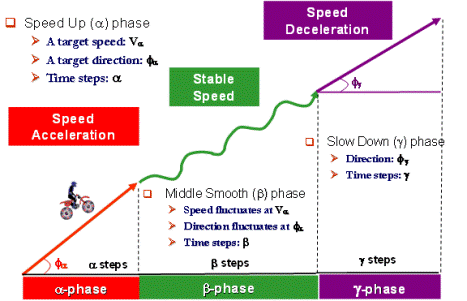Mobility Model
SMS Mobility Model Description

The Semi-Markov Smooth (SMS) mobility model is a novel mobility model in which each SMS movement contains a random number of equal-length time steps. According to the physical law of a smooth motion, a moving object would experience speed acceleration, stable speed and speed deceleration in one movement. And a temporal correlations exists during the velocity transition. Based on this observation, in each SMS movement, a node will randomly select a target direction φα and a target speed vα as the expected direction and speed of the movement. Each SMS movement contains three consecutive moving phases: Speed Up phase for even speed acceleration from 0 m/s to the target speed vα; Middle Smooth phase for maintaining stable velocities which respectively fluctuate around vα and φα in each time step; and Slow Down phase for even speed deceleration to 0 m/s. The node experiences a random pause time after each SMS movement.
SMS Mobility Model Properties
The Semi-Markov Smooth (SMS) mobility model is designed to specify the movements of individual users. Because i) it complies with the physical law of smooth motion, SMS model always generates smooth movements. According to its stationary moving behaviors, ii) the SMS model generates stable node speed without speed decay problem; and iii) it maintains uniform node distribution all the time. By adjusting model parameters, the SMS model can be easily and flexibly controlled to support various network scenarios. Therefore, the SMS model is a promising benchmark mobility model for both simulation and analytical study of wireless mobile networks.
Publications
- Ming Zhao and Wenye Wang, "A Unified Mobility Model for Analysis and Simulation of Mobile Wireless Networks," submitted for journal publications, December 2006.
- Ming Zhao and Wenye Wang, "A Novel Semi-Markov Smooth Mobility Model for Mobile Ad Hoc Networks," in the Proc. of IEEE GLOBECOM'06, (Best Paper Award), San Francisco, CA, November 2006.
- Ming Zhao and Wenye Wang, " Design and Applications of A Smooth Mobility Model for Mobile Ad Hoc Networks," in the Proc. of IEEE Milcom'06, Washington, D.C. October 2006.
Ns-2 Code of SMS Model
We are happy to share our code and documents with you. We only ask that any published research from using our code include a reference to the corresponding paper.
Please download the ns-2 code:smsdownload.tar
SMS Model FAQ
1. What’s the major difference between your model and the existing mobility models?
In short, there are three major differences: First, our SMS model abides by the physical law of a smooth motion, so that it describes more realistic moving behaviors. Second, by adjusting model parameters, the SMS model can be much more flexibly and easily controlled to support various network scenarios. Third, the SMS model has the desired steady state properties which are essential for both simulation and analytical study of MANETs.
2. What are applications for SMS Model?
SMS model considers the smooth movements of independent single user moving behaviors. The SMS model can be applied for both simulation and analytical studies. In terms or analytical study, the SMS model can properly characterize the relative movement between a pair of ad hoc nodes. Hence, it provides fundamental support for link performance, topology dynamics and network connectivity in MANETs. For simulation study, the SMS model can be utilized for routing performance evaluation, MANET design and optimization in different network scenarios.
3. Why uniform node distribution is suggested to use?
This is because for simulation and analytical studies of MANETs, mobile nodes are usually assumed to be uniformly distributed in a network. Therefore, the mobility model has uniform node distribution will not affect the analysis and simulation of system parameters, such as link change rate and network throughput of MANET which has initial uniform node distribution. In contrast, mobility model, such as random waypoint model, which generates non-uniform node distribution will cause biased simulation results for network with uniform node density.
4. How do you model the SMS model to specific networkenvironments?
Actually, the parameters configuration of SMS model depends on the particular types of moving pattern of mobile nodes in a specific network environment. The SMS model distinguishes itself from existing macroscopic mobility models in that it can capture the correlation of user mobility in a very small time scale, i.e., Delta t, which is in the order of seconds. As for simulation studies, Delta t can be configured according to specific requirements of time scale granularity, and target speeds of different types of mobile nodes. For example, the target speed of pedestrians may be around 2 m/sec, and 15 m/sec for a local school bus. In the configuration of phase duration time, the basic idea is that the higher the average speed of a node, the longer the phase duration for speed acceleration/deceleration. For instance, in real world, it normally takes at least 6 seconds for a car to accelerate its speed from 0 m/s to 20 m/s, but it just needs less than 1 second for a pedestrian to reach a walking speed of 1 m/sec. Therefore, in most of the simulation scenarios using SMS model, the beta--phase will predominate the movement duration, such that the range of beta phase duration (beta* Delta t) directly characterizes the duration of an SMS movement. Meanwhile, an SMS movement can also have very short beta-phase duration, but much longer alpha and gamma-phase duration. For example, a car travels intermittently along a road at the peak hour.
5. Why not use the real mobility traces obtained from campus-wide wireless network for SMS model. And what is the major difference between SMS model and the mobility models used for WLAN?
Actually, the applications of these mobility models and the SMS model are different. Specifically, the mobility model proposed from WLAN campus (Dartmouth, UNC, USC) traces are developed for evaluating the network resource usage, (for example, the session duration of each mobile user and the frequency that a user visits at various locations in a WLAN), the prediction of user locations and the WLAN design. These models describe more realistic mobility patterns; however, they are mathematically intractable and thus provide limited understanding for analytical studies. In contrast, the objective of the SMS model is to describe the individual user mobility according to the physical law of a smooth motion, which is not restricted by a specific network, such as WLAN. Moreover, the SMS model is suitable for both simulation and analytical study of MANETs.
6. Did you consider that SMS model could have sharp turn event between two successive movements?
Actually, the sharp turn events happened in the existing random models, when mobile nodes are moving. In our SMS model, a mobile node can only randomly select a new target direction for the next movement when it already stops or pauses after the current movement. This is the major difference. In fact, it is consistent with the reality of node moving behaviors, since after a pause time, the moving direction between two immediate movements could have a big difference. For example, a car stops first before it makes a right turn or U turn in the intersection of streets.
7. Why you believe that SMS model can appropriate for the routing performance or analytical study of MANETs?
There are two major reasons: First, our SMS model abides by the physical law of a smooth motion, so that it describes more realistic moving behaviors. Second, the SMS model has the desired steady state properties which can correctly indicate the network performance and provide appropriate analytical study.
8. Why you consider the steady state properties of your SMS model?
Steady state is a state in which equilibrium of a random process has been achieved, that is the network performance evaluation doesn’t rely on the factor of simulation time. Hence, only when the random process of a mobility model reaches the steady state, are the trace file and the corresponding simulation results reliable to provide correct performance evaluation. Therefore, the steady state properties of the SMS model are essential for studying MANETs.
If you have any question, please feel free to contact Ming Zhao
Related Publications
Fan Bai and Dr.Ahmed Helmy @ University of Southern California
- F. Bai, N. Sadagopan, A. Helmy, " The IMPORTANT Framework for Analyzing the Impact of Mobility on Performance of Routing for Ad Hoc Networks ", AdHoc Networks Journal - Elsevier Science, Vol. 1, Issue 4, pp. 383-403, November 2003.
- F. Bai, A. Helmy, " The IMPORTANT Framework for Analyzing and Modeling the Impact of Mobility in Wireless Adhoc Networks ", Book Chapter in the book on "Wireless Ad Hoc and Sensor Networks", Kluwer Academic Publishers. To appear June 2004.
- F. Bai, A. Helmy, " A Survey of Mobility Modeling and Analysis in Wireless Adhoc Networks ", Book Chapter in the book on "Wireless Ad Hoc and Sensor Networks", Kluwer Academic Publishers. To appear June 2004.
Toilers Group by Dr. Tracy Camp @ Colorado School of Mines
- T. Camp, J. Boleng, and V. Davies, A Survey of Mobility Models for Ad Hoc Network Research, Wireless Communication & Mobile Computing (WCMC): Special issue on Mobile Ad Hoc Networking: Research, Trends and Applications, vol. 2, no. 5, pp. 483-502, 2002.
- W. Navidi, T. Camp, and N. Bauer, Improving the Accuracy of Random Waypoint Simulations Through Steady-State Initialization, Proceedings of the 15th International Conference on Modeling and Simulation (MS '04) , pp. 319-326, March 2004.
- W. Navidi and T. Camp,Stationary Distributions for the Random Waypoint Mobility Model, IEEE Transactions on Mobile Computing, vol. 3, no. 1, pp. 99-108, January-March 2004.
- Vanessa Davies, Evaluating Mobility Models Within An Ad Hoc Network, M.S. Thesis, 2000.
Jungkeun Yoon and Mingyan Liu @ University of Michigan
- J. Yoon, M. Liu and B. Noble, "Random Waypoint Considered Harmful", in Proc. IEEE INFOCOM, vol 2, pp 1312-1321, April 2003, San Francisco, CA.
- J. Yoon, M. Liu and B. Noble, "Sound Mobility Models", in Proc. ACM MobiCom, September 2003, San Diego, CA.
- J. Yoon, M. Liu and B. Noble, "A general framework to construct stationary mobility models for the simulation of mobile networks", to appear, IEEE Trans. Mobile Computing, 2005.
Christian Bettstetter @ DoCoMo Euro-Labs (http://www.bettstetter.com/)
- Christian Bettstetter. Mobility Modeling, Connectivity, and Adaptive Clustering in Ad Hoc Networks. Utz Verlag, 2004. ISBN 3-8316-0397-9. (sample chapters )
- Christian Bettstetter, Hannes Hartenstein, and Xavier Paez-Costa Stochastic Properties of the Random Waypoint Mobility Model . ACM/Kluwer Wireless Networks , Special Issue on Modeling and Analysis of Mobile Networks, vol. 10, no. 5, pp. 555-567, Sept 2004.
- Christian Bettstetter. Node Distances, Node Degree, and Connectivity of Ad Hoc Networks with Random Waypoint Mobility . Technical Report TUM-LKN 2003/01 , Technische Universit München, Institute of Communication Networks, Munich, Germany, Mar 2003
- Christian Bettstetter, Giovanni Resta, and Paolo Santi. The Node Distribution of the Random Waypoint Mobility Model for Wireless Ad Hoc Networks . Technical Report TUM-LKN 2002/01 , Technische Universit?t München, Institute of Communication Networks, Munich, Germany, Sept 2002.
Jean-Yves Le Boudec @EPFL
- The Random Trip Mobility Model ,"Perfect Simulation and Stationarity of a Class of Mobility Models," J.-Y. Le Boudec and M. Vojnovic, IEEE Infocom 2005, Miami, FL, 2005 ( Infocom 2005 Best Paper Award) ) pdf.
- Other Mobility Model References
Copyright ©2026 North Carolina State University. All Right Reserved. Questions? Contact Dr. Wenye Wang




